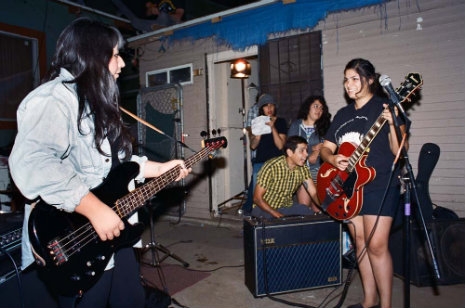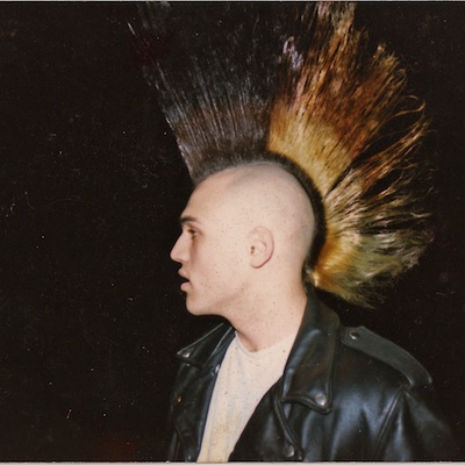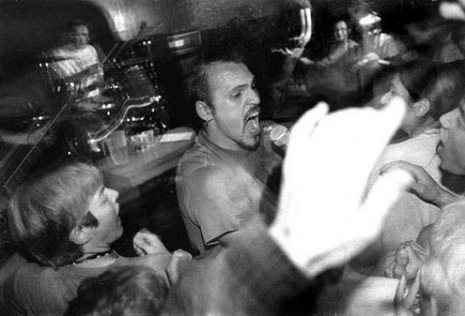
Angela Boatwright
Retrospectives of the early (1977-1984) L.A. punk scene can be counted on to include the same half a dozen bands (The Weirdos, The Controllers, The Skulls, X, The Screamers, Metro Squad) associated with Hollywood and the Sunset Strip. Only recently has more attention been given to the East L.A. scene, which was in many ways marginalized by cliques of the mostly white LA punks. Everyone knows who Exene is, but how many people can identify The Brat’s Teresa Covarrubias, who led the first all-female punk band in East L.A.? Not enough.
Photographer, filmmaker and Columbus, Ohio native Angela Boatwright has done a series of vignettes, “East Los,” about the current close-knit East L.A. backyard punk scene for Vans’ Living Off The Wall series. Yes, Vans is trying to sell stuff to the world and they obviously know their target market. But the often overlooked and overshadowed East L.A. scene, captured in former Los Crudos member Martin Sorrondeguy’s excellent documentaryBeyond the Screams (Mas Alla de Los Gritos), richly deserves to be seriously studied, and I guess the capital needs to comes from somewhere.

Angela Boatwright
Boatwright grew up listening to heavy metal and punk, taking from them the lessons of “be genuine. Don’t be afraid. Dive in even if you fail.” Her “East Los,” while well done and empathetic, is disjointed and doesn’t give the viewer a sense of the history of the scene, or why backyard shows were such a necessity in the beginning. A series based on the painstakingly researched 2008 Vexing: Female Voices from East L.A. Punk exhibit at the Claremont Museum of Art, curated by Colin Gunckel and Pilar Tompkins, would have been a better place to start.
Vexing should be given the opportunity to be shown to a wider audience at museums and galleries all over the country. The simpatico radical Franciscan nun and printmaker, Sister Karen Boccalero, who aided the East L.A. punks through the major Chicano arts center she had help found in the early ‘70s, Self Help Graphics, and the short-lived (six months) but hugely influential Club Vex held there, is an interesting character who would make a great documentary subject in her own right.
Los Illegals’ Willie Herron and The Brat’s Teresa Covarrubias have been very open about how bands like East L.A. bands like The Bags, The Brat, The Plugz, Los Illegals, Thee Undertakers, who fought the prevailing tendency to be pigeonholed as “Chicano” bands first, and punk bands only incidentally, were slowly given a chance to play “mainstream” venues who put on punk shows (“East L.A. Night at The Roxy” came in 1981) only after bands like X and The Blasters (and their fans) had openly given them their support. The Vex provided the bands with a local space to play every other Thursday night, along with families’ backyards and school dances, and network with poets, graphic artists, muralists, printmakers and performance artists.

Angela Boatwright
According to American Sabor:
California emerged as a hub of American punk music with L.A. considered as the most hardcore. In the mid-to-late 1970s, two distinct yet concurrent scenes arose in Los Angeles County: the Hollywood scene—not the fantasy film version but a city dominated by post-industrial poverty—and the East L.A. scene—12 miles to the east and fermenting its punk scene about a year later. Though two distinct punk scenes existed, they were not hermetically sealed. Crossing between the two scenes did occur and Chicanas influenced them both. However, those crossing were not without tension. Who could cross and under what conditions were questions that remained unresolved.
—snip—
While nearly all attention and fame focused on bands out of Hollywood, the vibrant punk scene in East L.A. grew. It gave us Los Illegals, East. L.A.‘s politically-charged diplomats and founders of the infamous Club Vex; The Brat, an all-female group led by Teresa Covarrubias who wrote socially-conscious lyrics against Mexican American oppression; The Plugz, D-I-Y punks who founded Plugz Records and later Fatima Records and went on to play with Bob Dylan on The David Letterman Show; and The Cruzados, a later incarnation of The Plugz who garnered praise from musicians and critics alike. While East L.A. nurtured Chicano and Chicana punks, the city’s racial stratification with undercurrents of prejudice continued against even U.S.-born Mexicans. The bands could not get signed performing in East L.A., which had no big venues and mostly consisted of backyard shows that would get shut down early by police. In order to be noticed a band typically had to come out of the West L.A. touring circuit, a paradox because almost all of the famous venues would not allow Chicano East L.A. punks to play.
“Living Off the Wall: East Los,” episode 1:
More of ‘East Los’ after the jump…







